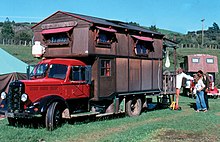Housetrucker

Housetruckers are individuals, families and groups who convert old
By the 21st century these
New Zealand connection
There are few places left in the world where housetrucking can be an uninhibited lifestyle with the kinds of simple homemade rigs New Zealand boasts. In other countries stringent laws regarding the roadworthy standards of older vehicles have forced many old housetrucks and buses from the roads and into graveyards of isolated farm paddocks and wrecking yards. Other laws concerning where one may park or camp have seriously restricted life on the road. The
Many housetruckers choose to travel in convoy, and in New Zealand there are trucker groups of families who travel together from city to city, and who assemble most weekends in different
Throughout the 1970s and 1980s many housetruck conventions and grass-roots festivals of all themes were held throughout New Zealand where housetruckers would converge, not only for the event, but for the opportunity to connect and share information with other truckers from across the nation. These events were conducted around areas considers as alternative lifestyle zones within the country. Many a low-key festival circuit was held throughout the regions of Coromandel, Northland, West Auckland, the west coast of the South Island and in the Nelson area.[6] For two decades Mollers farm at Oratia west of Auckland, a popular venue for blues and folk festivals,[7] offered an open house for truckers to park on a semi-permanent basis.
History

The idea of the nomadic styled mobile home was spawned from the international 1960s and 1970s
The first groups of housetruckers to travel in a co-ordinated convoy was the Nambassa Winter Show with Mahana in 1978 and then again Mahana traveling with the Roadshow Fayre after the 1979 Nambassa festival.[1]
Nambassa Winter Show with Mahana
The
The Nambassa festival connection

The New Zealand handcrafted house-truck fad essentially found its early roots around the period of the 1970s Nambassa alternative festivals. The annual mobile homes pilgrimage to Nambassa grew in strength, and creative design of trucks increased, as each festival unfolded, culminating in an amazing display of thousands of unique innovative rigs and vans at the 1981 festival. There were just a handful of inspiring-looking rigs in 1978, these wonderful early machines prompting a popularity explosion in this unique trucking culture. Many a jovial debate was had around camp fires arguing as to who actually built the first machines to adorn New Zealand roads.[1]
Throughout the 1980s many mobile homes frequented the
Nambassa
Between 1976 and 1981, hippie music festivals were held on large farms around
Road folk will insist that a mobile home is the ideal hippie set up for home ownership,
-
"Mahana Roadshow" at Nambassa 1979.
-
A very early seventies housetruck at Nambassa 1978.
-
1981 Mobile home at Nambassa.
-
Housetruck with development handmade wind-generator technology
-
1981 Nambassa.
Construction


Most 1970s mobile homes were constructed from the chassis upwards utilising predominantly cheap
See also
- The Flying Classroom
- Nambassa
- Nambassa Winter Show with Mahana
- New age travellers
- Recreational vehicle
- Small house movement
- Van-dwelling
References
- ^ ISBN 0589012169.
- ^ "Massey Magazine November 2001 | Educating Sonya". Archived from the original on 2018-02-19. Retrieved 2007-05-07.
- ^ Book Review – Home Free
- ^ Gypsy Fair
- ^ "Archived copy". Archived from the original on 2007-09-28. Retrieved 2007-05-07.
{{cite web}}: CS1 maint: archived copy as title (link) - ^ "Welcome to Visionz". Archived from the original on 2004-12-04. Retrieved 2007-05-07.
- ^ "www.aucklandfolkfestival.co.nz". Archived from the original on 2007-09-30. Retrieved 2007-05-07.
- ISBN 978-0-313-29913-1
- ^ Feature film documentary, "Nambassa Festival", A Cannes Film Festival entry, 2 hour documentary-New Zealand, 1980. The New Zealand Film Archive / Ngā Kaitiaki O Ngā Taonga Whitiāhua Archived 2007-04-09 at the Wayback Machine
- OCLC 923342368.
External links
- 150 images of Housetrucks/bus at Nambassa Festivals. Archived from the original on 22 July 2016.
- HousetrucksNZ. Archived from the original on 11 October 2015.
- Official Nambassa website. Archived from the original on 22 March 2018.





